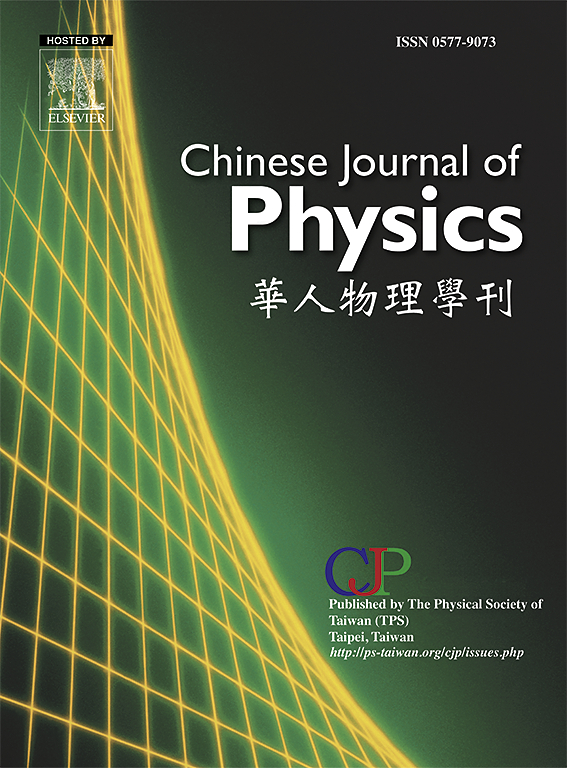Influence of next nearest neighbor interaction on the spin wave resonance frequency in ferromagnetic heterogeneous bilayer films
IF 4.6
2区 物理与天体物理
Q1 PHYSICS, MULTIDISCIPLINARY
引用次数: 0
Abstract
The next nearest neighbor (NNN) interaction is sometimes non-negligible for the application of spintronic devices in magnetic materials. Thus, understanding the contribution of the NNN interaction has been a significant research target. Although numerous approaches have been explored to control the NNN interaction, few reports of the competition of the NNN interaction of heterogeneous bilayer films have been presented. In this work, the spin wave resonance frequency of ferromagnetic heterogeneous bilayer films with the NNN interaction has been investigated using the linear spin wave approximation and Green's function methods. To clarify the contribution of the NNN interaction, the effects of the characteristic parameters of the system, such as interface coupling, surface anisotropy, external magnetic field, film thicknesses and symmetry, on the spin wave resonance frequency have also been studied in detail. It is found that the spin wave resonance frequencies of three lower-frequency modes depend strongly on the thickness of film. The frequency gap between the two neighbor modes is broadened when the thickness of the film is decreased. Besides, the NNN interaction and the symmetry play an important role in increasing the spin wave resonance frequency. Moreover, it is worth noting that the spin wave resonance frequency of the lowest-frequency mode depends weakly on the NNN interaction, the interface coupling, and the symmetry. Considering these effects in an opportune way, the spin wave resonance frequency of ferromagnetic thin film system can be controlled.

次近邻相互作用对铁磁非均质双层膜自旋波共振频率的影响
在磁性材料中自旋电子器件的应用中,次近邻相互作用有时是不可忽略的。因此,理解神经网络相互作用的贡献一直是一个重要的研究目标。尽管已经探索了许多方法来控制NNN相互作用,但很少有关于非均质双层膜的NNN相互作用竞争的报道。本文采用线性自旋波近似和格林函数方法研究了具有NNN相互作用的铁磁非均质双层膜的自旋波共振频率。为了明确NNN相互作用的贡献,还详细研究了系统的特征参数,如界面耦合、表面各向异性、外磁场、膜厚度和对称性对自旋波共振频率的影响。研究发现,三种低频模式的自旋波共振频率与薄膜厚度有很大关系。当薄膜厚度减小时,两个相邻模之间的频率间隙变宽。此外,NNN相互作用和对称性对提高自旋波共振频率也起着重要作用。此外,值得注意的是,最低频率模式的自旋波共振频率对NNN相互作用、界面耦合和对称性的依赖性较弱。适当考虑这些影响,可以控制铁磁薄膜系统的自旋波共振频率。
本文章由计算机程序翻译,如有差异,请以英文原文为准。
求助全文
约1分钟内获得全文
求助全文
来源期刊

Chinese Journal of Physics
物理-物理:综合
CiteScore
8.50
自引率
10.00%
发文量
361
审稿时长
44 days
期刊介绍:
The Chinese Journal of Physics publishes important advances in various branches in physics, including statistical and biophysical physics, condensed matter physics, atomic/molecular physics, optics, particle physics and nuclear physics.
The editors welcome manuscripts on:
-General Physics: Statistical and Quantum Mechanics, etc.-
Gravitation and Astrophysics-
Elementary Particles and Fields-
Nuclear Physics-
Atomic, Molecular, and Optical Physics-
Quantum Information and Quantum Computation-
Fluid Dynamics, Nonlinear Dynamics, Chaos, and Complex Networks-
Plasma and Beam Physics-
Condensed Matter: Structure, etc.-
Condensed Matter: Electronic Properties, etc.-
Polymer, Soft Matter, Biological, and Interdisciplinary Physics.
CJP publishes regular research papers, feature articles and review papers.
 求助内容:
求助内容: 应助结果提醒方式:
应助结果提醒方式:


